#rosetail betta
Text
Types of Betta Fish: Which One is the Best for You?
Types of Betta Fish: Which One is the Best for You?
Types of Betta fish is a trendy topic for every pet lover. One of the most well-known freshwater fish is the betta fish. They come in many different types and colors, which is why they are so popular.
Due to the wide range of variations, betta fish are typically categorized according to their colors, patterns, and tail types.
Their combative temperament frequently turns away beginners to the…
View On WordPress
#Betta Fish#Butterfly Betta#Crowntail Betta#Delta Tail Betta#Double Tail Betta#Dragon Scale Betta#Elephant Ear Betta#Halfmoon Betta#Koi Betta#Marble Betta#Plakat Betta#Rosetail Betta#Types of Betta Fish#Veiltail Betta
0 notes
Text

whoa he's a fish
#tales from the borderlands#borderlands#tftbl#rhys strongfork#kitkat art#this was supposed to be for mermay but I was. struggling. this is what I get for doing a more dynamic pose KDJFGA#no background for this cause I already shaded it for no reason#rhys is a mix of a rosetail betta fish (tail and fins) and a red rainbow fish (scale colors)
128 notes
·
View notes
Text


Get species swapped, nerds
#based Fanto on a rosetail betta and Barnaby on a leech (thus the lack of tail fin)#wanted a creative way to keep Ich's spots without just making them painted on so puppet Ich is made of (unfinished) birch wood!#billie bust up#fantoccio#bbu barnaby#species swap#oc#oc art#sona#Ich#my art
24 notes
·
View notes
Text

I do not think I have ever seen a betta with a tail this massive in person.
2 notes
·
View notes
Text


today's salami images. I've mostly kept plakats years ago so I'm always confused by how big his fins are. look at the length of those pelvic fins...
#g postin#bettas#domestic betta#he's such a droopy boy#in the past ive had 3? plakats and 1 rosetail but salami is def the least energetic of all#idk what breed salami is. just a big fin boy
5 notes
·
View notes
Text
What is Rosetail Betta fish
#top quality betta fish#betta fish for sale#premium betta fish#high quality betta fish#betta fish for sale near me#nice betta thailand#betta fish#siamese fighting fish#betta fish care#betta fish farm#Rosetail betta fish
0 notes
Text



happy MerMay!! have a concept doodle of merman Gale 🐠✨ he's loosely based on a rosetail betta fish!
since my Tav, Yv'ette, is a pirate - i decided i want to make a piece for MerMay involving her and Merman!Gale, so i wanted to flesh out his possible design
his color scheme (based on his canon outfit) kinda clashes unfortunately 😑 might tweak it for the next piece
193 notes
·
View notes
Text
Partner and I were very responsible- we went to the region's autumn Reptile Expo, and only left with one betta.
I always recommend people visit expos and trade shows, even if the primary focus is only tangentially related to your interests. I don't keep herps and I'm a novice with terrariums, but we like to go to gawk at what vendors bring and I peruse the horticulture offerings while Partner looks at the curiosities. Most people specialize in more than one thing, so it's like a treasure hunt.
First row I hit the jackpot- a reptile vendor who bred bettas on the side.
I must have spent fifteen minutes chatting with the owner and trying to decide which one I wanted. I was torn between a bicolor rosetail and a veiltail with coloring I'd never seen before. Since I couldn't decide I asked my partner to pick. They weren't interested in either of those, instead they were completely taken with a tiny male koi plakat shoved to the side in the first row. Not one I would have chosen but then I did hand the reins over.
Thus Mulberry entered our lives.
Frankly I think he should have been a cull. He's runty compared to the other stock the vendor was offering, and his mouth doesn't seem to be constructed quite right. He struggles to grab food. Truly a scrungly little man.

Then two days into quarantine I can't find the little fucker. It's a 5.5 tank. It's tightly covered. Filled with plants but not so dense I can't find a fish. Not behind the small internal filter, either. That left the filter itself. But there was no reason for him to enter, and it would be a tight fit even for a wee plakat. I opened the top and started pulling out parts anyway. Yep, saw a flash of scales in the murk.
Genius boy had somehow gotten past the two media plates in front and was in the main body, unable to escape. Brilliant little man.

God's Perfect Idiot.

#Every shortfin betta is a himbo#Twenty dollars for this boy who gets his ass kicked by a Hikari pellet#Mulberry betta#Fishblr#Bettablr#Reptile expo#Betta splendens#Plakat betta#Koi betta
51 notes
·
View notes
Text
Hybrid Bases - The Greenwood Prides
Being surrounded by other AUs with hybrid/magical cats eventually made an impression on me when I decided I wanted the Shores to have shark-tails. I wondered about it for a bit before remembering that I am the writer and I am allowed to do whatever I want with my story. So I am slowly hybridizing the sapient creatures of Strelles because I refuse to allow only the prides to be cool looking.
All of these bases were drawn by @sparkwing
---
Winds - Bat/Okapi


Long and slender forms with massive bat ears atop their heads. Leaf noses paired with sharp long, top tooth fangs and angular eyes. The Winds have flaps of skin between their tail and hindlegs alongside their forelegs and flanks. They have strong horns atop their heads which are useful both for digging and to defend themselves from the various hawks and eagles that roam their open-territory.
Runners/Escorts - along thin, whiplike tails mostly used for directional changes and signals
Tunnelers/Guards - short or completely stubby tails to keep them out of the way and aid in dirt clearing. Larger horns for combat and digging
Shores - Shark/Rosetail-Betta


Not completely water-perfect but they are streamline d I think. Cats of the Shores have medium-length, somewhat coarse glossy fur not unlike that of an otter's that fades into a shark-like tail. I imagined them are more like the tails of blacktip reef-sharks rather than that of a great white's. They have long catfish like whiskers that look silly drooping on land but are crucial for navigating when their rivers are murky. The fins around their necks are more decorative than functional, their only purpose really only meant to look pretty.
The Sacred Rank of the Shores - The Frills - are based more on lionfish with venomous spines lining their backs down to their rumps and on their forelegs which have fins webbed between them as well. Their fins have been pulled a bit back, connecting at the sides of their necks and going down their backs.
Shadows - Alligator/Snake


Long and somewhat lean forms with short fur and round heads. They don't really have ears so much as ear-flaps that resemble the ridges on a gator's head. Creeping Shadows have a few scales on their noses with ridges running down their spines into a powerful gator's tail useful for combat and balance.
The Anacondas are much more snake-like taking on the hoods of a snake (capable of being closed of course) and a combination of a snake and gator's tail with spines down the tail but with a rattle on the end.
Bonus! Spark colored one of the Shadow cats

Thunders - Boar/Owl


Muscular and solid forms with thick, protective fur meant to defend them from the thorns and brackens strewn throughout their thick forest territory. The Thunders have large tusks paired with an under-bite. They have a thick collar of feathers around their necks remiscent of a lion's mane - with some being larger and more plush than other’s at times.
The Strix of the forest is granted feathered legs and lose their cat's stails altogether. One of their defining traits is the large, sharp talon on their forepaws.
(Will finish the image descriptions when I have more energy)
8 notes
·
View notes
Text
Best 5 Types of Female Betta Fish
Let's see today the the types of female betta fish, Female betta fish, also known as Siamese fighting fish, exhibit a stunning array of colors and patterns, adding beauty and diversity to aquariums.
While not as flamboyant as their male counterparts, female bettas possess their own unique charm and come in various types distinguished by their coloration, finnage, and markings.
Types of Female Betta Fish
-
Veiltail Female Bettas - Betta Fish
Veiltail female bettas are characterized by their long, flowing fins that trail behind them, resembling the delicate folds of a veil. Their fins lack the exaggerated length and fullness seen in male veil tails but still possess an elegant appearance. Veiltail females come in a wide range of colors, including vibrant reds, blues, and pastel hues.
-
Crowntail Female Bettas - Betta Fish
Crowntail female bettas feature striking fins with serrated edges, giving them a crown-like appearance. While not as elaborate as male crown tails, female crown tails exhibit beautiful finnage with webbing that extends beyond the edges of their fins, creating a mesmerizing effect. Their fins may display a variety of colors, often with contrasting patterns.
-
Halfmoon Female Bettas - Betta Fish
Halfmoon female bettas are prized for their expansive finnage, which forms a near-perfect semicircle when fully extended. While not as pronounced as in male halfmoons, female halfmoons exhibit broad, symmetrical fins that create a stunning display when they flare. Their fins may showcase vibrant solid colors or intricate patterns, adding to their allure.
-
Plakat Female Bettas - Betta Fish
Plakat female bettas, also known as short-finned bettas, have shorter fins compared to other varieties, giving them a more streamlined appearance. While lacking the elaborate finnage of other types, plakat females compensate with their vibrant colors and feisty personalities. They are often sought after for their active swimming behavior and resilience.
-
Rosetail Female Bettas - Betta Fish
Rosetail female bettas possess fins with an abundance of overlapping rays, creating a ruffled or rosette-like effect. This unique finnage gives them a luxurious appearance, with fins that cascade and overlap in intricate patterns. Rosetail females come in a wide range of colors, from bold solid hues to delicate pastels, making them highly sought after by enthusiasts.
Conclusion
So today we see the type of female betta fish Female betta fish exhibit a diverse range of types, each with its own distinct characteristics and beauty. Whether you're drawn to the graceful fins of veil tails, the regal appearance of crown tails, the expansive finnage of half-moons, the streamlined elegance of plakats, or the luxurious ruffles of rosetails, there's a female betta type to suit every aquarist's preference.
By understanding the different types and their unique traits, hobbyists can appreciate the beauty and diversity of female bettas in the aquarium hobby.
Also Read -
Unlocking Secrets: Aquascaping and Polar Blue Parrot Cichlids
Best 2024 Parrot fish a comprehensive guide
{2024} Best Facts and Details about Koi Fish
Best Trout Fish in English – A Dive into the World of Prized Aquatic Beauties
Read the full article
1 note
·
View note
Note
anubis and java fern are probably good! it was several years ago so i honestly dont even remember the specific ones i had, but they were fake plants so they were kinda stiff and he got stuck in a little spot between some of the leaves. most aquatic plants are probably pretty good, but in my experience bettas are shy little dudes sometimes so they'd probably really like anubis and java so they can hide in the leaves haha. my guy was also a little stupid and tried to fight anything that was more colorful than him, so keep that in mind if u decorate your tank 💀 did you have a specific kind of betta in mind? i had a blue halfmoon :)
Ooohhh they were fake plants, see I’ve read a few things that said fake plants like that will tear fins, so I’m gonna try my best to steer clear of those! I think these specific plants will be right for me to get started honestly, I’m super excited!
I didn’t know these don’t react well to colorful things..I was planning on keeping the tank as natural looking as possible, I thought that would make the little fishy feel more comfortable :3
As for what kind I want, I really would like to get a half moon, I think they’re just stunning and so beautiful to look at. I wouldn’t mind a veiltail or a rosetail, I think those two are also very pretty🥰 color wise I think I would want a blue one if I can find one! my fiancé also really likes the blue ones and I’m trying to convince him to let us get one in the first place hehe
0 notes
Text
Betta fish OHM Rosetail Grizle Mustard Butterfly
#betta fish for sale#high quality betta fish#top quality betta fish#premium betta fish#betta fish for sale near me#betta fish care#nice betta thailand#betta fish#betta fish farm#siamese fighting fish#Betta fish OHM Rosetail Grizle Mustard Butterfly
1 note
·
View note
Text
Jasper :)







Finally decided against naming him ares because he's just too dumb to be named after the god of war; he's gotten stuck in the filter twice idk what to do with him
#betta#betta fish#betta splendens#rosetail betta#dw about the filter thing#ive got a sponge filter coming in a few days#until then i just had to take a ton of water out of his tank LMAO#so he cant reach it
25 notes
·
View notes
Text

SIP Raymond, 2019-2021.
My boy passed away today, after a prolonged battle with fin rot that left him wasted away and barely able to swim. This is the last picture I took where his fins are still (mostly) intact.
After months of salt dips, relocations and pH adjustments, I guess it all finally got to be too much for him. I wish I could say he went peacefully, but it seemed like a long and slow struggle, and he didn’t stop fighting even at the end.
I think I’m stepping away from bettas for the time being. It’s just... so hard seeing them suffer through almost inevitable health issues, especially when they’re so beautiful and full of personality to start.
Goodbye, buddy. You were a good fish, and you will be missed.
#fishblr#bettablr#fishkeeping#SIP#rosetail betta#fin rot#fish death#I feel awful#I’ll miss this guy#just like his predecessor bodhi he got me through some really hard times#I could’ve have asked for a better fish
9 notes
·
View notes
Text
My little betta boy Percy checking out his new set up! I love making some new diggs for my fishy. Added some duckweed up top and converted the abubias plant from being planted to a decoration over to drift wood with a little shifting of the other already used material.

#fish#aquarium#betta#rosetail betta#percy the mother fucking fish#happiness#pets#animals#marimo moss#duckweed#anubias nana#drift wood#5 gallon tank#fish dad#betta log
3 notes
·
View notes
Text
What’s wrong with bettas?
Annnd as promised, here’s that write-up on betta genetics and what’s wrong with all those pretty genes. We’ve got pictures and everything. This is a full, comprehensive list of the various problems with domestic betta traits. If you’re in the market for a new angry pal, then there’s a list of “good” things to look for in a betta at the end.
Just a quick intro before we begin: I’ve been into fishkeeping for over a decade, I currently have 16 running tanks ranging from 5 to 440 gallons, I’ve got about 200 fish at the moment, and I’ve had a good 20 to 25 bettas of my own over the years. When I was younger, I even bred a pair of pet store veiltails together, and reared some of the fry into adulthood. So, this is information coming from someone has both seen these things firsthand and talked with many, many other betta keepers who have done the same.
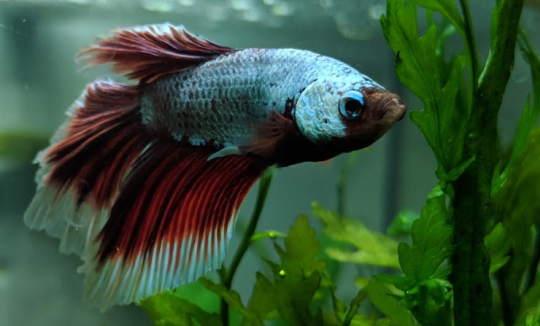
This is my new betta, Embezzlement. He looks great, right? He really does! But he’s also quickly going blind as a result of his thickened scales growing over his eyes, his fins will end up dragging him down to the point of immobility as he ages, and he’s at high-risk for developing visible tumors all over his body. I’ll get into that under the cut!
(To learn more about why the heck I willingly bought Bezel, just click the link attached to his name up there.)
((I don’t own any of these photos, or bettas, unless noted))
The Dragonscale Gene

We’ve all seen these boys and admired them. Please refer to my totally pro image mashup above and look at the thickened, shiny scales. That’s dragonscaling. It comes in white, grey, blue, and teal; and it can cover any part of the body, including the fins. Some have masks of dragonscaling, some have full body coats, and some just have intermittent patches. Most dragonscale bettas start developing noticeable dragonscaling at 1-2 months, and it continues spreading from that point on.

Now, if it was just a pretty shimmery gene, that would be great! But it isn’t. Dragonscales are abnormally thick scales that spread everywhere, even over their eyes. You can see the scales start to circle around the cornea on the left, and a progression on the three fish to the right. Once the scales reach the eyes, it’s only a matter of time before they go completely blind. (This is basically a guarantee for bettas with dragonscaling on their face.) If you don’t want a blind betta that can’t safely navigate its environment, stay away from those opaque, shiny, thick scales.
The Marble Gene
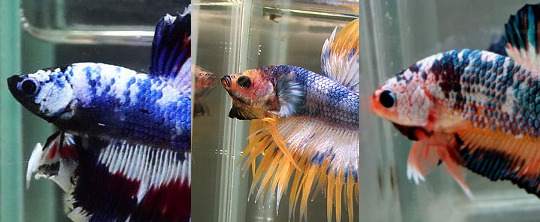
If you’ve ever seen a pretty “koi” betta covered in colorful blotches? That’s a marble. A weird, flesh-toned betta with neat speckles? That’s a marble. If you’ve ever seen a betta that’s changed colors over the span of its life? That’s 100%, definitely, without a doubt, a marble. The prevalence of marbles in the market is for 3 reasons: 1) it’s considered a dominant gene, 2) marbles are pretty rainbow boys, and 3) it’s also really, really hard to breed back out of lines.
So, the thing about marbles is... their pigment cells are constantly mutating. They can completely change colors in a couple months. Your red and black and white koi that you paid $30 for might turn into a muddy maroon right before your eyes. And since their cells are constantly mutating, you guessed it—

They’re prone to developing tumors. Yeah. They go lumpy even faster than the average betta.
Blue Bettas and Graphite Disease
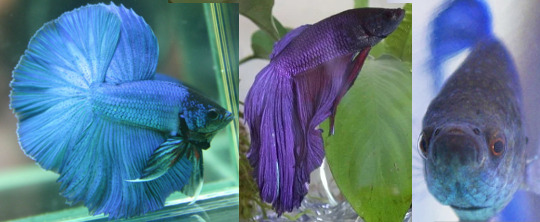
Nah, not even the comparatively boring bettas are safe. Bettas that are 90-100% blue with little other coloration on their bodies? They’re prone to graphite disease, which is a fast-acting killer with no known cure.

Their fins and bodies start turning grey, like someone shaded them with a pencil, and then boom: they’re dead within a few days. This is likely due to their reduced ability to process carotenoids, which are the substances responsible for increased red pigment. They also play an important role in keeping the immune system functioning properly, so without those.... yeah. They get sick even more easily than your average betta, and they die even more easily than your average betta. Also. Graphite disease. Not a fun time.
Red Bettas and Tumors
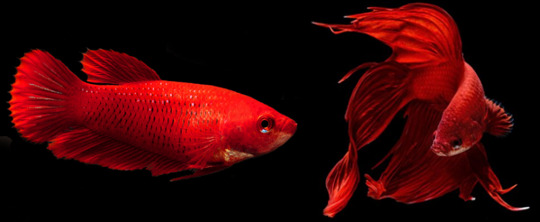
Pure red bettas are some of my favorites. Red is a symbol of good luck in Southeast Asia, where bettas are primarily bred and shown, so they’re also an important part of the industry. However, to get that pure, solid red coloration in a fish that’s descended from these guys:

You’ve got a lot of inbreeding to do. Linebreeding, inbreeding, crossing back, whatever you want to call it. It can be beneficial to show lines if you’re doing it right, because breeding the offspring of an animal back to its parent intensifies all of the traits that were passed onto it. However, with fish that are and have always been treated as trinkets, no one bothers screening for the negative traits that are being compounded along with the coloring.
So, red bettas are a whole mess of health issues, but they’re very prone to developing tumors. This is, unfortunately, one of the ones I have plenty of experience with. When I was younger, I had a male veiltail with solid red coloring, and he turned into a mass of lumps before dying. The same thing happened with my most recent betta, Genie. She was in my care for all of 9 months before I had to put her down, as there were multiple little tumors developing all over her body, and a large one over her internal organs that was visible from the outside.

Here’s a side by side comparison. From the day I got her to the day I euthanized her so she wasn’t in pain. For those of you who don’t know about her, she was the pond betta who lived in a 440 gallon blackwater biotope and fed a live insect-based diet. The pH in there is 5.8, the temp is 78F, the water quality is always 0/0/0, and there weren’t any environmental stressors that contributed to her decline in health. She was kept in the best conditions I could possibly give her, and she still went that far downhill in 9 months. She wasn’t a full year old.
Unfortunately, it gets worse from here! Get a glass of water, grab some snacks, we still have fin types to cover.
Halfmoons and Rosetails
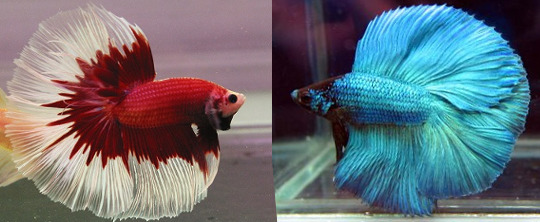
You see those two gorgeous guys above? Those are halfmoon bettas, one of the most popular and commonly available types of bettas! Note how dang big those fins are. They only have them fully extended like that when they’re flaring. Now, look at this picture of a halfmoon with his fins in the normal position:

See how they collapse into a long, ruffled shape? Two things here. 1) Those fins are literally useless and hinder them from swimming properly, so they have to exert way more effort than necessary to even move around. This is how we get that signature “betta wiggle” that people find endearing. To properly drag those massive fins around and keep them from dragging, they have to undulate their whole body in an exaggerated manner, which gets harder and harder as they age.
And 2) This leads to fin biting. Note how that poor guy’s tail is all tattered and shorter than his ventral and dorsal fins. When bettas are weighed down by their own fins? Their solution is, a lot of the time, to self-mutilate and nip them off. The jury is still out on whether or not they have feeling in their fins; but even if they don’t, they’re still opening themselves up to potential infections. Plus.... even the fish don’t want those draperies. C’mon. You know it’s not good if they’re literally tearing themselves to shreds just so they can swim again.
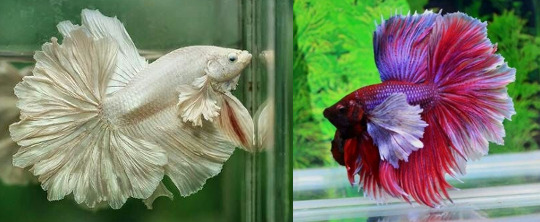
Can’t forget rosetails, either! That blind pal on the left and living tulle skirt on the right are bred for fins that go over the halfmoon point (they aren’t a semi-circle, they’re more like a pizza with a couple slices taken out) and have enough bulk that they stay ruffled even when they’re flaring. For obvious reasons, these are even worse than halfmoons. Oh god those poor fish.
Crowntails
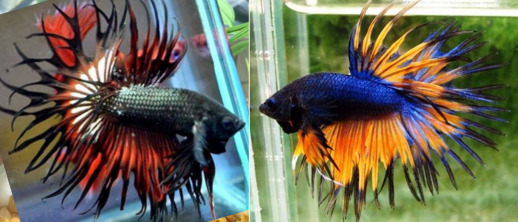
These spiky boys are crowntails, another common fin type seen in Petsmarts and Walmarts everywhere. Not much to say about them that wasn’t covered under the halfmoon section. They’re fin biters, because even though they don’t have as much fin mass, those tendrils still create large amounts of drag and hinder their movement.
Doubletails

We took a halfmoon and we made it worse. That.... that takes skill. These genetic abominations were specifically bred to have not one, but two tails! And I’m not sure how much truth there is behind this, but their spine is supposed to split into two portions to create that Y shaped tail. Obviously, that would strain their spine and create a whole handful of new problems, on top of that further decreased swimming ability. (After Bezel passes, I’ll probably get a doubletail and see if that spine thing checks out.)
Congrats! You made it to the bottom!
Now, here’s what to look for, if you want to buy a healthy(er) betta.
If you’ve been in a pet store recently and looked at the shelf with all the bettas on it, you can probably recognize some of these traits in 9/10 fish. And if they’re not lying on their side on the edge of death, they’ll probably look good and healthy and tempting to take home.
Remember how screwed up those bettas are, though, and get one of the better options. Here’s a list of questions to ask yourself before taking a betta home.
Male or female? When it comes to fin types, females will almost always be better off than males. Thanks to sexual dimorphism, female bettas have shorter, less exaggerated fins. Therefore, a crowntail female can swim about as easily as a plakat (read: short-finned fighter type) or veiltail betta. If it’s a female, just make sure the fins aren’t bitten or weirdly long. If it’s a male, see below.
How drastic are the fins? The shorter, the better. Just make sure they aren’t short because they’ve bitten them off. Also, veiltails are one of the healthiest fin types currently available, because they’re an “undesired” trait, and have wider gene pools as a result of not being inbred to a severe degree. They're functional, too! These boys can swim.

How pretty is it? If the betta looks like a galaxy painting threw up on it, then chances are, it’s gonna have some issues later in life. You want a betta that’ll hopefully live for years? Get an ugly one. Orange, yellow, tan, peach, dirty white, whatever. Stay away from those solid reds/whites/blacks/blues. Those two boys above are great examples of “ugly” bettas. Even though the one on the left is marble, he still has a better chance of living a good life than an inbred solid black disaster.

If you want something a little fancier than a fish that looks like.... well, kind of like flesh, get a cambodian! Their coloration is a variation of piebald. They’re characterized by a light, peachy body and colorful fins. They’re pretty flesh fish. These were actually one of the earliest types of domestic bettas, fun fact.
How shiny is it? Shiny scales don’t automatically mean they betta is a dragonscale carrier. For example, compare these crowntail and plakat (that fighter-type mentioned above) males to the true dragonscales at the very top. Lightly shimmery scales that naturally fade into the body aren’t dragonscales. If they’re the same size and thickness as the rest of the scales, they probably aren’t dragonscales. You can get an eye for telling the two apart after awhile.
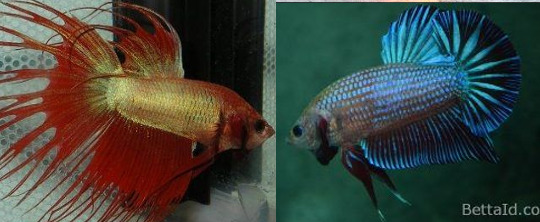
And that’s it, that’s the show. Thanks for reading!
This guide was written on 2/03/2019 and will be edited as necessary.
2/08/2019: edited to remove swearing
#long post#bettablr#fishblr#aquablr#this took so damn long oh my god#but it's done! and it should be useful!#crowntail#halfmoon betta#rosetail betta#dragonscale#veiltail betta#betta tag
6K notes
·
View notes